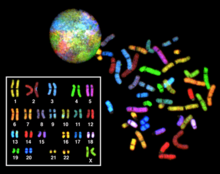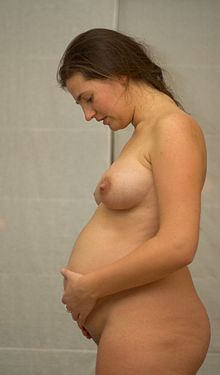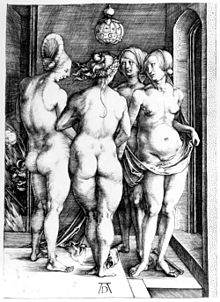Woman
![]()
This article is about people of the female gender - for other meanings, see Woman (disambiguation).
Frau (Middle High German frouwe, from Old High German frouwa "distinguished, high woman; mistress", as Old High German frō to Germanic fraujan "lord"), Latin and technically also femina, denotes a female adult human being. Female children and adolescents are referred to as girls. The polite form of address for a woman in German is Frau, followed by the surname of the person addressed. In some sports, the term Dame is still common.
Females with typical genetic development have a pair of chromosomes XX and, unlike males, are usually able to become pregnant and bear children from puberty to menopause. The female anatomy, unlike the male, includes the fallopian tubes, ovaries, uterus, vagina, vulva, paraurethral gland, and Bartholin's glands. The adult female's pelvis is wider, hips are wider, and breasts are larger than those of an adult male. Women have significantly less facial and other body hair, a higher body fat composition, and are on average smaller and less muscular than men.
Throughout human history, traditional gender roles have often defined and restricted women's activities and opportunities (compare femininity). Particularly with the achievement of universal suffrage for women, role restrictions loosened in many societies during the 20th century (compare gender order); women gained access to professional fields, opportunities for advancement and higher education, and were no longer confined to traditional housewife roles.
The word "woman" in its original sense refers to the biological sex "female", in more recent usage it also refers to a female gender identity, for example in transgender persons who identify as women (compare gender). A trans woman was assigned the male gender at birth, while an intersex woman may have gender characteristics that do not entirely correspond to the typical characteristics of female biology.
.jpg)
A compilation of 20 portraits of women
Biological characteristics
→ Main article: Human sex differences
Genetic characteristics
From a molecular biological point of view, women differ from men by the chromosome pair XX in the sex chromosomes. This difference leads to a sexual dimorphism and forms the chrimosomal sex. Due to the coincidence of an X chromosome from the maternal side (ovum) and an X chromosome from the paternal side (sperm) in the zygote, this arises in relation to the formation of the sex organs already during embryonic development. Females usually have two X chromosomes in their chromosome set, whereas males usually have only one X chromosome and the sex-determining Y chromosome, on which the sex-determining region of Y (SRY) is located and which, in males, is responsible for the embryonic production of the testis-determining factor (TDF), a protein. If TDF is produced, male characteristics are formed. In the absence of TDF, female characteristics are formed. Due to various genetic causes, an embryo can therefore exceptionally develop into a female baby despite having a 46.XY chromosome set (see also XY woman).
Morphological and physiological characteristics
Women differ physically from men in the primary and secondary sexual characteristics, the somatic sex. The primary sexual characteristics of women are the actual female sexual organs, which are mostly located in the body and serve for reproduction. Women's secondary sexual characteristics include, for example, breasts, body shape, less body hair, and voice.
The internal sex organs of the woman consist of the uterus located in the body with the paired fallopian tubes as well as the female gonads, the ovaries, in which the eggs are created and mature as female germ cells. The uterus is connected via the vagina to the vulva, which forms the external primary sexual organ of the woman. The vaginal outlet is located between the labia minora and labia majora in the vaginal vestibule, into which the urethra also opens as the outlet of the urinary bladder. At the front fold of the labia minora lies the clitoris as a cylindrical, erectile organ formed by erectile tissue, which is interspersed with sensitive nerve endings and is therefore particularly capable of reacting to touch.
After the birth of a child, breast milk is formed in the female breasts, which, together with the mammary glands in them, belong to the secondary sexual characteristics and do not develop until puberty. The mother can use this milk to breastfeed the newborn until it can be fed with other food (baby food).
In addition to the different reproductive organs and breasts, there tend to be some other physical differences between men and women, which are also referred to as tertiary sexual characteristics. For example, the female bone structure, especially in the pelvis, sometimes differs significantly from the male. The facial skull differs slightly, and the amount of muscle and the distribution and expression of fatty tissues are also usually different than in men. The female body tends to be less muscular than that of the male; while the proportion of skeletal muscle tissue in females averages about 23 per cent, in males it is about 40 per cent. The difference is mainly due to the effect of the male sex hormone testosterone, which has a strong muscle-building effect. As a result, an averagely built woman can only develop about 65% of the muscle strength of an average man. Also hormonal is a higher susceptibility of women to the bone-degrading disease osteoporosis, which affects about 25% of women after menopause and is mainly caused by the lack of estrogen production after menopause. This disease can also occur in men, but is less common and usually occurs at an older age.
There is another striking difference between the sexes in the frequency spectrum of the human voice due to the different size of the larynx and length of the vocal cords.
The degree to which physical characteristics, insofar as they are also individually present, are regarded as "typically female" depends on upbringing and imprinting. All women also have so-called "male parts" - and vice versa (see femininity as well as masculinity).
Hormonal characteristics and menstruation
→ Main article: Menstrual cycle
A major difference between men and women is formed by the hormonal makeup and the menstrual cycle controlled by it. The hormonal regulation is mainly caused by the interaction of the follicle-stimulating hormone (FSH hormone), which is formed in both sexes in certain cells of the anterior lobe of the pituitary gland (adenohypophysis), and the estrogens and progesterone formed in the ovaries in follicles and the corpus luteum, as well as the luteinizing hormone.
The cycle consists of a regular and approximately monthly rhythm, in which the maturation of an egg in an ovarian follicle in the ovary takes place until ovulation about halfway through the cycle. While the egg moves via the fallopian tube to the uterus, the follicle becomes a corpus luteum and is finally completely degraded. Parallel to the maturation of the egg, an endometrium is formed in the uterus and a mucus plug (cervical mucus) in the area of the cervix, which in the event of fertilisation can take up the zygote then forming and nourish it as a placenta. If fertilisation and embedding of the egg does not occur, the endometrium is broken down again at the end of the cycle and leads to the woman's menstrual bleeding.
In addition to the altered levels of the hormones involved, which in the case of FSH, LH and oestrogens peak at ovulation and in the case of progesterone rise and fall again during the second half of the cycle, as well as the organic changes in the endometrium and the cervix, the woman's basal body temperature also changes, rising after ovulation and falling again until menstruation.

Schematic representation of the ovarian cycle

Woman with baby

female karyotype

Pregnant woman
The woman in the history of culture
The role of women in society varies from culture to culture and has changed, sometimes significantly, over time and as cultures have evolved.
Women in prehistory and primitive peoples
Among recent and historical primitive peoples, the role of women varies. In most peoples, she primarily takes on the role of raising and educating children and therefore usually stays close to the settlements. In hunter-gatherer cultures, she is usually the person who tends the fire and prepares the food; in addition, she gathers or gathered plant food and small animals around the camp as a food base and prepares the food, while the man is usually out hunting and providing the protein-rich meat. In traditional digging and hoeing cultures, most of the work of providing food is done by the women, and as a result matriarchal structures often prevailed in these peoples. In contrast, among nomadic pastoralist peoples, she plays a lesser role in food procurement.
Some anthropologists, such as Margaret Ehrenberg, assume that prehistoric women were more respected than men. For the early hunter-gatherer groups, female members may have been economically more important because of the greater consistency of yields as gatherers compared to the changing success of hunters. With their ability to give birth, women contributed to the maintenance of the group. The fact that the mother of a child can always be named beyond doubt, but this does not apply to paternity, is said to have strengthened the role of women within the group. Whether it is possible to speak of a gender hierarchy at all for prehistory is, however, disputed.
In game-herding cultures, men were responsible for hunting. Meat with its protein and fat was a precious food, especially in cold, northern latitudes. Women secured the nutritional basis by gathering fruits, herbs and seeds; however, female hunters have also been documented. While the men roamed, women took care of the rest of life: preparing food, tending the fire after it had been tamed, stockpiling food, building huts, nursing infants, and raising small children in groups. Women formed the more stabilizing, tightly woven network of the group.
Around the ability of women to give life, the first cults and religions are said to have emerged in the Palaeolithic, in which ancestresses and mainly female deities were worshipped. This idea serves as the basis for the widespread but not undisputed idea that a matriarchy can be assumed for prehistory. With archaeological means, however, it is not possible to make such far-reaching statements about the form of society.
According to Ehrenberg, women are said to have played a significant role in the development of agriculture and other cultural techniques or to have invented them. The new economic method was accompanied by a significant population growth in the Neolithic period, as production surpluses could be hoarded for the first time. As a result, the first social differences developed. In this process, which lasted for several thousand years, it is assumed that the symbolic or actual primacy of women or the equality of the sexes shifted permanently in favour of men. This was probably due to a greater involvement of men in agricultural plough cultivation and harvesting, together with large and small animal breeding and husbandry, which weakened the position of women.
ancient women
Classical antiquity was organized patriarchally and the role of women was subordinate to that of men. In ancient Greece, women were limited to their household duties and had limited legal capacity.
This was also true in ancient Rome, where the woman was largely subordinate to the father or husband without rights. In the home, however, she was independent and a married woman enjoyed social respect. Around 100 BC, her legal status was increasingly improved.
→ Main article: Women in Ancient Rome
The Germanic tribes as well as other peoples were also strongly organized patriarchally. Here the woman was without legal capacity and passed from paternal authority to that of the husband. However, respect for the woman, who was also considered a potential seer, and the duty to protect a woman mitigated the harshness of the law and potential punishments by the man.
Women in early Christianity
In the letters of Paul there are hints that women might have taken leading roles in early Christianity. In the first letter of Paul to the Corinthians there is the "Pauline commandment of silence" for women in the church community. But there are assumptions that it was added later, because in the same letter it is written about how women should pray or speak prophetically.
Basically, however, in the early church, with the growing importance in Rome, the role and position of women did not change. She was considered the "vessel of sin". Men had legal gender guardianship over wives until the time of the Frankish Empire in the 5th to 9th centuries. This increasingly declined towards the Middle Ages and became a duty of assistance and factual stewardship in legal matters.
Women in the late Middle Ages to modern times
In the later Middle Ages, due to wars, feuds and diseases, there was a strong surplus of women in society, which led to sociological problems. For every 1000 men there were 1150 women, i.e. a surplus of about 15%, and women became more important in the economic and commercial life of the cities. Due to the new trades founded by women from about 1300 onwards, the prestige and social position of women increased until about 1650. They were able to assert themselves especially in branches of the economy not organised by guilds and to have equal importance with men in wholesale and retail trade. Legally, women in trade were in part placed on an equal footing with men, for example in the Hamburg city law of 1603.
However, some of these laws were withdrawn in the late Middle Ages and early modern period, and by the recollection of ancient ideals in the Renaissance, as well as by the contemporary interpretation of Roman law and the witch hunts. The latter in particular led to massive bondage of women who risked being persecuted and killed by accusations of witchcraft and "sexual abnormalities". About 100,000 women fell victim to this persecution.
From about the second half of the 17th century, women of the upper social classes increasingly succeeded in gaining access to higher education and thus established the status of the "learned" and later the "gallant woman". In the Rococo period, it was primarily these women who helped to shape social and intellectual development. In the late 18th and 19th centuries, women such as Rahel von Varnhagen and Bettina von Arnim became central figures in the literary salons, and some women such as Anna Luise Karsch and GeorgeSand were able to establish themselves as writers. It was also at this time that the political women's movement began, campaigning for legal equality for women and their independence in public life. It was not until the General German Commercial Code of 1897 that women regained their former legal status in commerce; at about the same time and shortly thereafter, women in individual countries gained the right to stand for election and later also the right to vote.

Albrecht Dürer 1491: The four witches

Mandan girls picking berries (Edward S. Curtis, c. 1908)

The care of the children inevitably restricts the mobility of the women (Yanomami woman with child)
Search within the encyclopedia